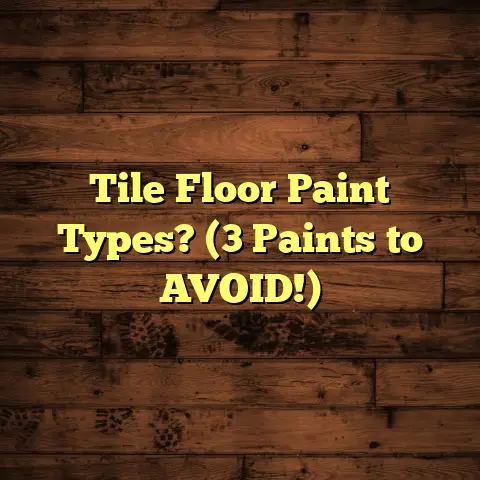Zep On Vinyl Plank? (7 Cleaner Mistakes!)
Why did the broom get a promotion?
Because it swept everyone off their feet!
But let’s be real, when it comes to cleaning vinyl plank flooring, not all brooms (or cleaners) are created equal.
I’ve seen it all in my years as a flooring contractor.
And trust me, I’ve seen some real messes.
Today, we’re diving deep into the world of vinyl plank flooring and the popular cleaner, Zep.
We’ll uncover the common mistakes homeowners make when cleaning with Zep and, more importantly, how to avoid them.
Think of me as your flooring guru, here to guide you through the cleaning jungle!
So, buckle up, grab your favorite beverage, and let’s get started!
Here’s a sneak peek of what we’ll be covering:
-
Understanding Vinyl Plank Flooring: What it is and why it’s so popular.
-
The Role of Cleaners: Why choosing the right one is crucial.
-
The 7 Deadly Sins of Cleaning: Mistakes you need to avoid.
-
Extra Tips: General best practices to keep your floors sparkling.
Let’s keep those planks happy and healthy for years to come!
Section 1: Understanding Vinyl Plank Flooring
Vinyl plank flooring has taken the flooring world by storm, and for good reason.
It’s durable, stylish, and often more budget-friendly than hardwood.
But what exactly is it?
Vinyl plank is a type of resilient flooring made from synthetic materials like PVC.
It’s designed to mimic the look of real wood or stone, offering a wide range of styles and colors.
Benefits:
- Water Resistance: A huge plus for kitchens and bathrooms.
- Durability: Stands up to daily wear and tear.
- Affordability: Often cheaper than hardwood or tile.
- Easy Installation: Many options are DIY-friendly.
- Low Maintenance: Relatively easy to clean and maintain.
I’ve seen vinyl plank used everywhere, from high-traffic commercial spaces to cozy homes.
Its versatility is undeniable.
According to a report by MarketWatch, the global vinyl flooring market is expected to continue growing, driven by its affordability and durability.
That said, even with its impressive durability, vinyl plank isn’t indestructible.
Proper maintenance is key to keeping it looking its best and extending its lifespan.
Think of it like this: you wouldn’t drive your car without changing the oil, right?
Same goes for your floors!
And that’s where cleaners come in.
Section 2: The Role of Cleaners in Maintaining Vinyl Plank
Now, let’s talk about cleaners.
Choosing the right cleaner for your vinyl plank is like choosing the right fuel for your car.
You wouldn’t put diesel in a gasoline engine, would you?
Zep is a popular choice, and I’ve used it myself on numerous occasions.
It’s known for its cleaning power and availability.
But is it always the right choice?
Zep: A Closer Look
Zep offers a range of cleaning products, and some are specifically formulated for vinyl and other hard surfaces.
These cleaners often contain a blend of:
- Surfactants: To lift dirt and grime.
- Solvents: To dissolve grease and stains.
- pH Adjusters: To optimize cleaning performance.
- Fragrances: To leave a fresh scent.
The effectiveness of Zep comes down to its ability to break down dirt and grime without damaging the vinyl surface.
However, it’s crucial to use the right Zep product and use it correctly.
Using the wrong cleaner, or using it improperly, can lead to:
- Dulling of the Finish: Making your floors look lackluster.
- Residue Buildup: Attracting more dirt and grime.
- Surface Damage: Scratches, discoloration, or even warping.
I’ve seen homeowners use all sorts of cleaners on their vinyl plank, from bleach to ammonia.
Trust me, those are not good ideas.
According to the Vinyl Flooring Institute, you should always use pH-neutral cleaners specifically designed for vinyl floors.
Now, let’s dive into the common mistakes I see people make when using Zep (or any cleaner) on their vinyl plank.
Section 3: The 7 Cleaner Mistakes
Alright, let’s get to the nitty-gritty.
These are the seven most common mistakes I see homeowners make when cleaning their vinyl plank floors.
Avoid these, and you’ll be well on your way to having floors that look fantastic for years to come.
Mistake 1: Using Too Much Cleaner
This is a classic mistake.
We tend to think that more cleaner equals more clean.
But that’s simply not true.
Overusing cleaner can leave a sticky residue on your vinyl plank.
This residue attracts dirt and grime, making your floors look even dirtier in the long run.
Plus, it can dull the finish, making your floors look lackluster.
I remember one client who was using a whole cup of cleaner in a bucket of water!
Her floors were constantly sticky and dull.
Once we reduced the amount of cleaner, her floors looked dramatically better.
The Fix:
Always follow the manufacturer’s instructions for dilution.
Less is often more.
Start with a small amount of cleaner and increase it only if necessary.
Mistake 2: Not Diluting the Cleaner
On the flip side, not diluting the cleaner can be just as bad.
Concentrated cleaner can be too harsh for vinyl plank, potentially damaging the surface.
It can also leave behind a thick, difficult-to-remove residue.
I once saw a homeowner who poured undiluted cleaner directly onto their floors!
The result was a streaky, sticky mess that took hours to clean up.
The Fix:
Always, always, always dilute the cleaner according to the manufacturer’s instructions.
Use a measuring cup or spoon to ensure accurate dilution.
Don’t eyeball it!
Mistake 3: Using the Wrong Tools
The tools you use to clean your vinyl plank are just as important as the cleaner itself.
Abrasive tools, like steel wool or scouring pads, can scratch and damage the surface.
I’ve seen homeowners use these tools to try to remove stubborn stains, only to end up with scratched and scuffed floors.
The Fix:
Opt for soft cloths, microfiber mops, or sponge mops.
These tools are gentle on vinyl plank and won’t scratch the surface.
For tough stains, try a soft-bristled brush.
Just be sure to use it gently!
Mistake 4: Ignoring Manufacturer Guidelines
This is a big one.
Every vinyl plank flooring manufacturer has specific recommendations for cleaning and maintenance.
Ignoring these guidelines is like ignoring the instructions for assembling IKEA furniture.
You might get it done, but it’s probably not going to look pretty.
Some manufacturers may recommend specific cleaners or cleaning methods.
Others may warn against using certain types of cleaners.
I’ve seen homeowners void their flooring warranties by using the wrong cleaners!
The Fix:
Read the manufacturer’s guidelines before you start cleaning.
You can usually find this information on the manufacturer’s website or in the flooring installation guide.
Follow their recommendations to the letter.
Mistake 5: Failing to Test in an Inconspicuous Area
Before you use any new cleaner on your vinyl plank, it’s crucial to test it in an inconspicuous area.
This could be in a closet, under a rug, or behind a piece of furniture.
Testing the cleaner will allow you to see how it reacts with your flooring without risking damage to a visible area.
I always recommend this to my clients.
It’s a simple step that can save you a lot of headaches.
The Fix:
Apply a small amount of cleaner to an inconspicuous area.
Let it sit for a few minutes, then wipe it away.
Check for any discoloration, damage, or residue.
If everything looks good, you can proceed with cleaning the rest of your floors.
Mistake 6: Cleaning Too Frequently or Infrequently
Cleaning frequency is a balancing act.
Cleaning too frequently can strip away the protective finish on your vinyl plank.
Cleaning too infrequently can allow dirt and grime to build up, making your floors look dull and dirty.
I’ve seen homeowners who mop their floors every day!
While their intentions are good, they’re actually doing more harm than good.
The Fix:
Aim for a regular cleaning schedule that suits your lifestyle and the amount of traffic your floors receive.
Generally, once a week is sufficient for most homes.
For high-traffic areas, you may need to clean more frequently.
Spot clean spills and messes as soon as they occur.
Mistake 7: Neglecting to Rinse After Cleaning
This is another common mistake that can lead to residue buildup.
Even if you’re using a properly diluted cleaner, it’s important to rinse your floors with clean water after cleaning.
This will remove any remaining cleaner residue and prevent it from dulling the finish.
I’ve seen homeowners skip this step, only to find that their floors look dull and streaky after a few weeks.
The Fix:
After cleaning your floors with a cleaner, go over them again with a mop or cloth dampened with clean water.
Be sure to wring out the mop or cloth thoroughly to avoid leaving excess water on the floors.
Section 4: Additional Tips for Maintaining Vinyl Plank Flooring
Beyond avoiding these cleaning mistakes, here are some additional tips to keep your vinyl plank looking its best:
- Sweep or vacuum regularly: This will remove loose dirt and debris that can scratch the surface.
- Use doormats: Place doormats at entrances to trap dirt and moisture.
- Avoid harsh chemicals: Never use bleach, ammonia, or other harsh chemicals on your vinyl plank.
- Protect from sunlight: Prolonged exposure to direct sunlight can fade the color of your vinyl plank.
- Use furniture pads: Place furniture pads under the legs of furniture to prevent scratches.
Conclusion
So, there you have it!
The seven deadly sins of cleaning vinyl plank flooring, and how to avoid them.
Remember, proper cleaning and maintenance are key to keeping your vinyl plank looking its best for years to come.
Avoid these common mistakes, and you’ll be well on your way to having floors that sparkle and shine.
Now, if you’ll excuse me, I’m off to sweep someone off their feet!
Just kidding (sort of).
Happy cleaning!
I hope this article has been helpful.
If you have any questions, feel free to ask!





